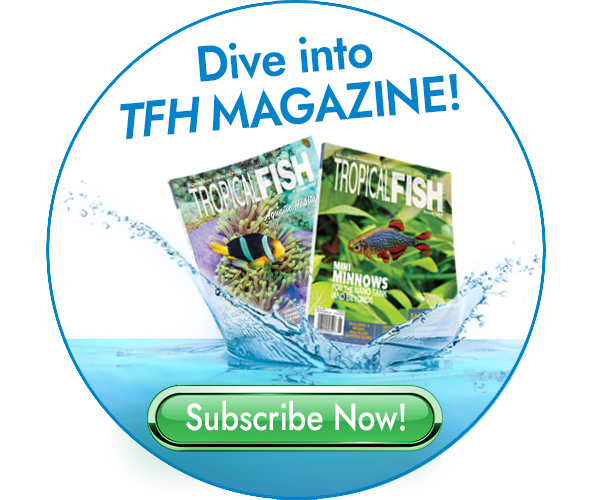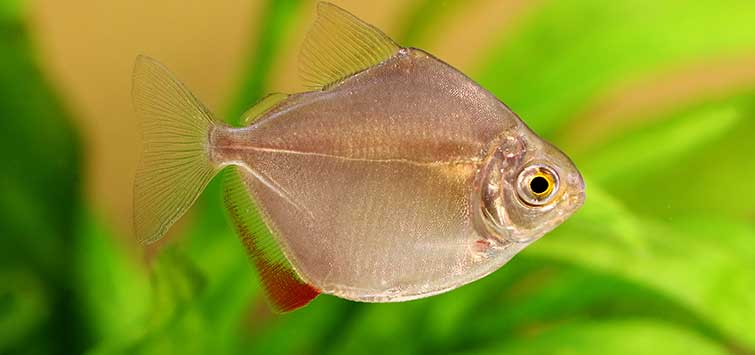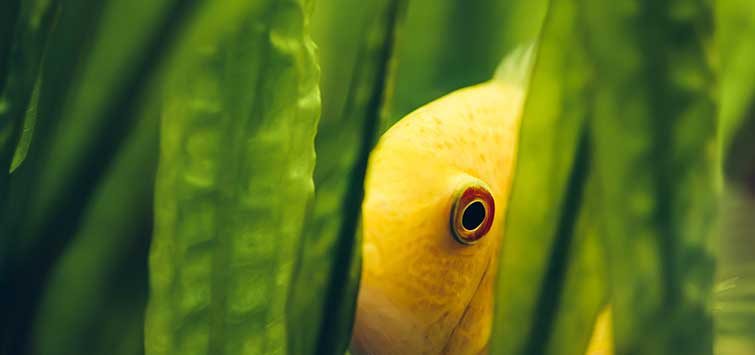A No-Fuss Planted Aquarium
Author: Michael Grossman
If you’re daunted by all of the prevalent high-tech aquascapes but still want a lush planted tank for your home, there are techniques that can help you create a simple, low-cost setup.
How to Build a Beautiful Aquarium on a Budget
If you are a regular reader of aquarium magazines and books, you have no doubt seen stunning Nature Aquarium setups and have felt inspired. But then you take a look at everything involved in such a setup—all the high-powered lighting, exotic substrate mixtures, a chemistry set full of test kits, CO2 injectors, fertilizers, substrate heaters, expensive pumps, and strange plants never seen at your local fish store—and your motivation wanes. You can, however, still have a reasonably lush, low-hassle, low-maintenance, low-startup-cost planted aquarium using only generic equipment, easy plants, and supplies available at big retail stores or pet shops.
This is by no means the definitive approach for a budget planted aquarium, but it is one idea for a setup easy enough to maintain that even the Big Lebowski himself could manage the upkeep. An aquarium or two does not have to become a part-time job.
Here in Florida, I am using untreated, hard well water with a pH of about 7.4 and 1 to 2 ppm of phosphate. The room temperature ranges from 80° to 83°F during the period of March to November because air conditioning is expensive. I make 20 to 30 percent partial water changes on a weekly basis.
Tank, Lighting, and Stand
First, buy the biggest aquarium you can afford and your floor can support. (If you live in a modular or mobile home, consider carefully the sobering fact that a full 55-gallon tank weighs more than 500 pounds! A few years back, I got a 55 and my trailer always seemed a bit more wobbly.) I recommend large tanks not on account of machismo but because a large body of water reacts more slowly to temperature and chemical changes, providing a more stable environment. I like to use 48-inch-long 40- and 55-gallon tanks, as this length is just right for a shop light. The 40-gallon breeder tanks are less desirable, since a 48-inch shop light hangs over a few inches on each side.
A cheap, lightweight, and simple option for an aquarium stand is wrought iron. These stands are sold fully assembled at most local fish stores. While not as colorful as a wooden stand, I find curvy wrought iron gives a minimalist, even Victorian, look to the fishroom.
To cover the aquarium, just use a simple glass cover. This allows just about any light source to fit on top of the tank so you have the option to experiment with different light sources or scavenge lights from smaller tanks you might find online or at garage sales.
Most home improvement stores and other big-box stores stock 48-inch plant and aquarium bulbs for shop lights. A shop light with fixtures for two of these fluorescent bulbs is adequate for a moderate- to low-light 55-gallon or a moderate- to high-light 40-long. For shorter tanks, you can find fluorescent grow lights in sizes that fit easily on 20- or 30-gallon long/tall tanks.
I strongly prefer long tanks because shallower water attenuates the light less. If the light is too intense, simply cut a couple of 2 x 4 boards and place them under the ends of the shop light to elevate it a little. To increase intensity, a reflector can be added (or you can even make your own). Also, since shop lights do not have an on/off switch, a timer, which would give you control over the day length, would be a good idea as well.
Filtration and Heating
Cost and convenience are the priorities, so a generic hang-on-the-back filter is the product of choice. Easily replaced, utilizing filter media available from both large retailers and fish stores, and virtually idiot proof, you really cannot go wrong with one of these filters. The only issue I have had with hang-on-the-back filters is noise. Some brands may sound like coffee grinders, while others are really as quiet as the box claims. Save the receipt; you might have to try a few different brands to find the one you like best.
For emergencies, consider buying battery-powered air pumps. Available in the fishing section of sporting goods in most retail stores and at local fish stores, these run on D-cell batteries for a long time and will help circulate and aerate your water in the event of a power outage. (This happens a lot, even in the more densely developed parts of Florida.)
A word of caution on heaters: They can and do fail. I usually have to buy new ones each winter and regularly check the temperature in my tanks when heating is in use.
Decorations and Gravel
A nutrient-rich substrate is essential and may not be available at big-box stores or even some local fish stores. Typical aquarium gravel, which is usually just little painted pebbles, is of no use for growing plants. Decent-quality gravel is the one thing you should spend some money on.
I have used a mixture of fluorite and a nutritive soil substrate complete with nitrifying bacteria for many years to successfully grow plants of the genera Cryptocoryne, Anubias, Echinodorus, Aponogeton, and Hygrophila. These products are much more expensive than regular gravel but are well worth it. Fluorite gravel is the color of Georgia clay, and all of the rooted plants mentioned here can be grown in it. Fluorite’s main drawback is that it is very dusty. I mix in varying amounts of black nutritive substrate in order to vary the bottom color of my planted tanks. While it is not impossible to grow plants in other types of gravel, starting with nutrient-rich gravel saves you the recurring expense and hassle of putting iron supplement tablets into the gravel.
Driftwood and rocks are my preferred non-living decoration. Driftwood will stain the water at first and lower the pH somewhat as tannins come out. Rocks can also affect water chemistry. To avoid any surprises, use artificial wood ornaments and rocks. Realistic-looking plastic rocks and wood, while pricey, are a one-time expense and will eliminate potentially costly water chemistry problems later on. In addition, hollow plastic displaces less water than real stone or wood, leaving more volume for fish. (I have even observed coralline algae being fooled into growing on a plastic rock in my marine tank!)
Plants
Plants are of course the main feature, whatever your fish tank budget. All of the plants discussed I have found at both big-box retail stores and local fish stores. All of them are relatively inexpensive, and several are even obtainable for free in local rivers (be sure to check your local laws before attempting to collect any type of aquatic plants). All of the plants below have done just fine growing in fluorite without high-intensity lighting, fertilizers, or CO2 injection.
· Anubias barteri:I am always pleasantly surprised by the beauty that can be attained in a tank with only one or two plant species given a little patience. The African plant Anubias barteri var. “nana,” for example, took over the bottom of my small, poorly lit 30-gallon in about 24 months. Anubias are slow growers. Remember not to bury the rhizome. Just anchor the rhizome to a rock or a driftwood piece near the bottom of the tank so it can send roots into the gravel. Most Anubias varieties look very similar. Anubias barteri var. “barteri,” which grows twice as tall as Anubias barteri var. “nana,” is also an easy Anubias. Avoid the taller Anubias species because they are much more difficult to care for than Anubias barteri varieties. Other Anubias also tend to be rarer and more expensive, so it will probably be easier to find A. barteri.
· Hornwort (Ceratophyllum demersum): Hornwort is a rootless floating plant that obtains all of its nourishment from the water. Nevertheless, just for looks, some choose to plant it in the gravel. It is a fast grower, particularly if it is allowed to float at the surface close to the lights. Ceratophyllum can be found floating near the shore in many ponds and rivers on the East Coast of the United States, including throughout Florida.
· Aponogeton spp.: To add seasonal variation to your aquascape, Aponogeton bulbs can be planted. Aponogeton retreat into their bulbs periodically and then come back. Resting periods probably correspond to the dry season in their native habitat. These plants grow tall with moderate to high light levels but get by under lower light, remaining small. The bulbs can be purchased dry in most stores. I am unsure as to the exact species of Aponogeton, which is probably A. crispus, A. undulatus, or A. ulvaceus; the package usually doesn’t say.
· Nymphaea Lilies: Nymphaea lilies have attractive rust-colored leaves and send lily pads up to the surface. I have not observed them ever to flower in the (uncovered) aquarium but have frequently seen them produce pink flowers above the water in ponds. Nymphaea bulbs are readily available.
· Cryptocoryne spp.: Many species in the genus Cryptocoryne are also easy, slow growers, have moderate light needs, and require infrequent trimming. This stands in contrast to the Amazon sword (Echinodorus sp.), which has fast growth that produces many old leaves, which need to be removed to prevent detritus buildup. Although easy to grow, I gave up on Echinodorus because my favorite fish, the zebra loach (Botia striata), ruins the plant by munching on its foliage. Loaches and other omnivorous species have shown no interest in Cryptocoryne leaves. Cryptocoryne sometimes turn to mush and then slowly recover after being transplanted—a process called melting—so they are a little more difficult than Anubias spp.
· Hygrophila polysperma: With intense light, this plant can grow very quickly, quickly enough in fact as to become a hassle to trim. With a 48-inch shop light described above on a 55- or 40-gallon tank, the growth rate will be more moderate. It is easily propagated: Trim to the desired height, strip away the leaves from the bottom of the stem, and plant the cutting. Also known as dwarf Hygrophila, this invasive Asian plant may not be available at your local fish stores. It can be found in ponds, ditches, and rivers in Florida. Listed by the federal government as a noxious weed, transport of this plant has been banned in some states, including Florida.
· Elodea sp.:Elodea, formerly known as anacharis, is a fast-growing plant that can grow roots or remain floating. Not as buoyant as Ceratophyllum demersum, this plant can be found growing at all levels of the aquarium. I trim it often and use the clippings for compost. Easily collected near the shores of lakes and rivers in Florida, I have also observed sail-fin mollies (Poecilia latipinna) nibbling on it in the Withlacoochee River.
The aquarium equipment and plants needed to set up a low-maintenance, moderate-light, well-planted aquarium can be found mostly at large retailers and at most pet shops, even those that do not specialize in fish. Some plants can even be found growing wild if you live in the southeastern US. CO2 injection, fertilizers, and high-wattage lighting can certainly enhance plant growth but are not required. With only a very modest effort and expense, a well-planted aquarium can be purchased and maintained for years.
Aquarium Checklist
· Wrought iron stand
· Generic hang-on-the-back filter rated for a 30- to 60-gallon tank
· Heater for a 30- to 60-gallon tank
· Glass cover
· 48-inch shop lights
· Two 48-inch plant and aquarium light bulbs
· Timer
· 2x4 board
· Two 20-pound bags of fluorite or nutritive substrate
· Battery-powered air pumps (optional, for emergencies)
· Reflector (optional)
Plant Checklist
· Anubias barteri var. “barteri”(taller)
· Anubias barteri var. “nana”(shorter)
· Cryptocoryne spp.
· Hornwort(Ceratophyllum demersum)
· Aponogeton sp. (Guess which kind is in the bulb!)
· Hygrophila polysperma (may be banned in your area)
· Elodea sp.
See the full article on TFH Digital http://www.tfhdigital.com/tfh/201208#pg81

.png?h=595&iar=0&w=2781&hash=5FD5E69473BCC22199FBFA2FB71B6033)



